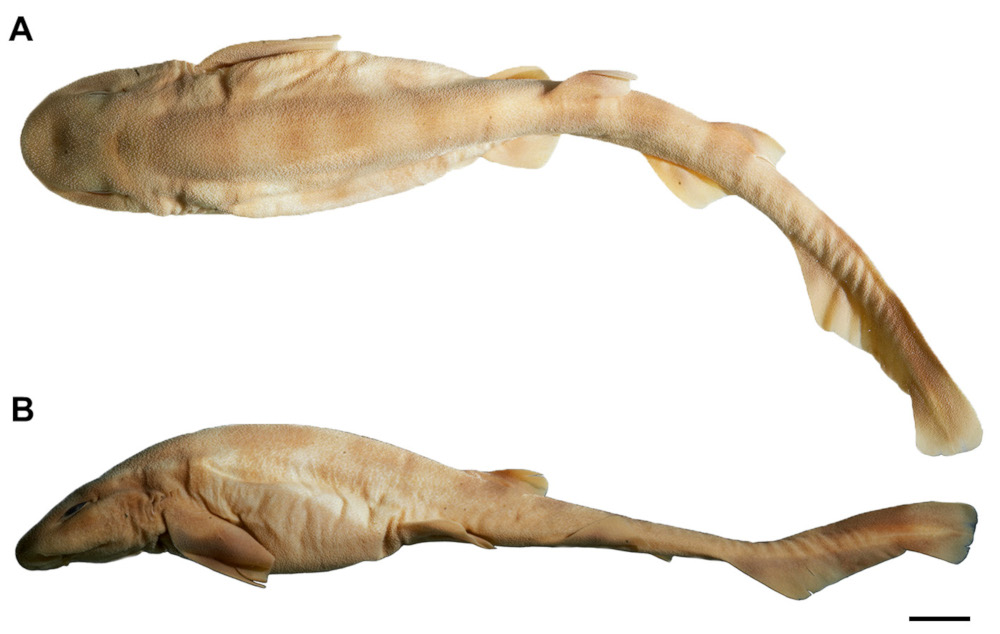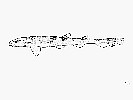Scyliorhinus meadi
Springer, 1966
Blotched catshark
Classification: Elasmobranchii Carcharhiniformes Scyliorhinidae
Reference of the original description
A review of Western Atlantic Cat Sharks, Scyliorhinidae, with descriptions of a new genus and five new species. Fishery Bulletin, 65(3), 581–624
A review of Western Atlantic Cat Sharks, Scyliorhinidae, with descriptions of a new genus and five new species. Fishery Bulletin, 65(3), 581–624
Image of the original description

Scyliorhinus meadi Springer, 1966

Scyliorhinus meadi Springer, 1966
Synonyms / new combinations and misspellings
Scyliorhinus retifer meadi
Scyliorhinus retifer meadi
Description :
Citation: Scyliorhinus meadi Springer, 1966: In: Database of modern sharks, rays and chimaeras, www.shark-references.com, World Wide Web electronic publication, Version 12/2025
Please send your images of "Scyliorhinus meadi" to info@shark-references.com

Scyliorhinus meadi Springer, 1966, holotype, USNM 188049, male, 267 mm TL (Florida, United States, 28º21’N 79º51’W). A, dorsal view; B, lateral view. Scale bar = 20 mm © Karla A. Soares, Laboratório de Ictiologia, Departamento de Zoologia, Instituto de Biociências, Universidade de São Paulo

Scyliorhinus meadi Springer, 1966, holotype, USNM 188049, male, 267 mm TL (Florida, United States, 28º21’N 79º51’W). A, dorsal view; B, lateral view. Scale bar = 20 mm © Karla A. Soares, Laboratório de Ictiologia, Departamento de Zoologia, Instituto de Biociências, Universidade de São Paulo
Common names
 Alitán pintarrajo,
Alitán pintarrajo,  Roussette cloquée,
Roussette cloquée,  Blotched cat shark,
Blotched cat shark,  Blotched catshark
Blotched catshark
 Alitán pintarrajo,
Alitán pintarrajo,  Roussette cloquée,
Roussette cloquée,  Blotched cat shark,
Blotched cat shark,  Blotched catshark
Blotched catshark
Short Description
Diagnosis after Compagno, 1984 [517]: Field Marks: A fairly large, stocky dark-saddled catshark without spots, small anterior nasal flaps that end just in front of mouth, no nasoral grooves, labial furrows on lower jaw only, second dorsal fin much smaller than first. Diagnostic Features: Head and body relatively broad and wide, greatest width of head about equal to head length; no nasoral grooves; anterior nasal flaps not expanded and falling just short of mouth. First dorsal origin opposite or somewhat anterior to pelvic insertions; second dorsal origin somewhat anterior to anal insertion; interdorsal space slightly greater than anal base. Denticles moderate-sized and flat, skin surface relatively smooth. Colour pattern of 7 or 8 dusky and- sometimes obscure saddles, without black or light spots. Size probably large, immature male 49 cm.
Diagnosis after Compagno, 1984 [517]: Field Marks: A fairly large, stocky dark-saddled catshark without spots, small anterior nasal flaps that end just in front of mouth, no nasoral grooves, labial furrows on lower jaw only, second dorsal fin much smaller than first. Diagnostic Features: Head and body relatively broad and wide, greatest width of head about equal to head length; no nasoral grooves; anterior nasal flaps not expanded and falling just short of mouth. First dorsal origin opposite or somewhat anterior to pelvic insertions; second dorsal origin somewhat anterior to anal insertion; interdorsal space slightly greater than anal base. Denticles moderate-sized and flat, skin surface relatively smooth. Colour pattern of 7 or 8 dusky and- sometimes obscure saddles, without black or light spots. Size probably large, immature male 49 cm.
Distribution
southeastern coast of United States, between Florida and the Bahamas (24ºN, 79ºW), north to Cape Fear, southern South Carolina (34ºN, 75ºW) [27296] Source: www.gbif.org
southeastern coast of United States, between Florida and the Bahamas (24ºN, 79ºW), north to Cape Fear, southern South Carolina (34ºN, 75ºW) [27296] Source: www.gbif.org
Human uses
fisheries: of no interest
fisheries: of no interest
Dentition
Monognathic heterodonty gradual well developed; anterior teeth abruptly larger than the parasymphysial ones and lateral teeth smaller distally, with smaller and thicker principal cusps (Fig. 59). Sexual heterodonty not observed; only females examined. Tooth counts 23–26 23–26/21–24 1 21–25 (27–27/24–25). Parasymphysial teeth with a principal cusp flanked by one cusplet on each side; cusplets 1/3 the height and half the width of the principal cusp. Protuberances on medial portion of the crown base and striae running from the crown base toward the apex of the principal cusp. Anterior teeth larger than the parasymphysial and principal cusp less stout. Anterior teeth with four cusplets; marginal cusplets poorly developed. Anterior lower teeth with marginal cusplets more developed and corresponding to half the height of principal cusp. Protuberances on the crown base and striae throughout the crown, more prominent in upper teeth. Lateral teeth with three cusplets; two cusplets at the mesial edge and one at the distal edge. Mesial proximal and distal cusplets corresponding to half the height of principal cusp and mesial marginal poorly developed. Principal cusp slightly oblique in both jaws. Protuberances on the crown base and striae throughout the crown. Commissural teeth with one or two cusplets; principal cusp stronger, slightly oblique and laterally situated. Cusplets corresponding to half or 2/3 the width and the height of the principal cusp. Protuberances present and striae throughout the crown. Ectodermal pits present in lateral and commissural teeth, restricted to the crown base. [27296]
Monognathic heterodonty gradual well developed; anterior teeth abruptly larger than the parasymphysial ones and lateral teeth smaller distally, with smaller and thicker principal cusps (Fig. 59). Sexual heterodonty not observed; only females examined. Tooth counts 23–26 23–26/21–24 1 21–25 (27–27/24–25). Parasymphysial teeth with a principal cusp flanked by one cusplet on each side; cusplets 1/3 the height and half the width of the principal cusp. Protuberances on medial portion of the crown base and striae running from the crown base toward the apex of the principal cusp. Anterior teeth larger than the parasymphysial and principal cusp less stout. Anterior teeth with four cusplets; marginal cusplets poorly developed. Anterior lower teeth with marginal cusplets more developed and corresponding to half the height of principal cusp. Protuberances on the crown base and striae throughout the crown, more prominent in upper teeth. Lateral teeth with three cusplets; two cusplets at the mesial edge and one at the distal edge. Mesial proximal and distal cusplets corresponding to half the height of principal cusp and mesial marginal poorly developed. Principal cusp slightly oblique in both jaws. Protuberances on the crown base and striae throughout the crown. Commissural teeth with one or two cusplets; principal cusp stronger, slightly oblique and laterally situated. Cusplets corresponding to half or 2/3 the width and the height of the principal cusp. Protuberances present and striae throughout the crown. Ectodermal pits present in lateral and commissural teeth, restricted to the crown base. [27296]
Remarks
shark-references Species-ID=6332;
shark-references Species-ID=6332;



















